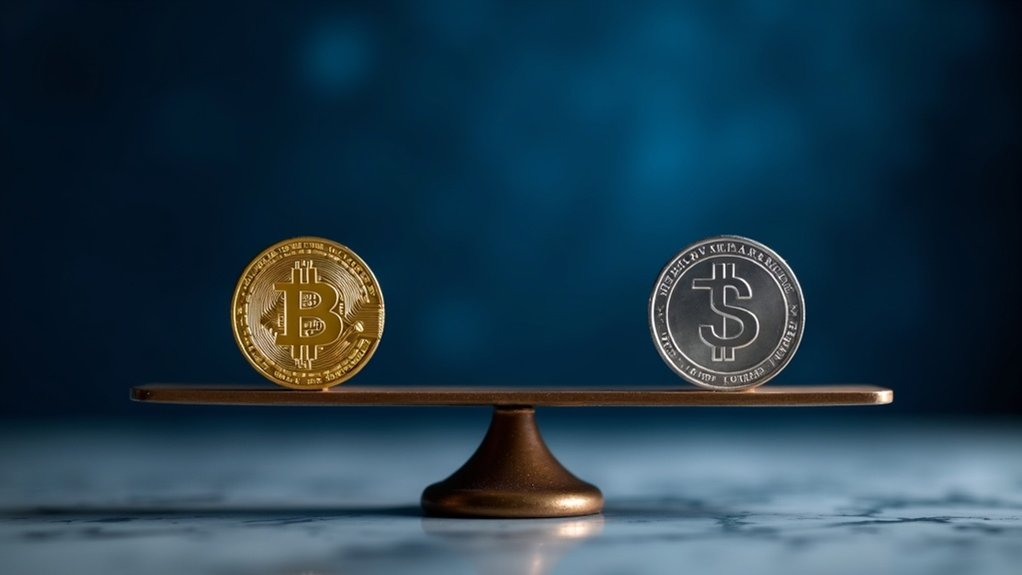OTC crypto trading happens away from public exchanges. It’s direct dealing between two parties—no nosy onlookers. High rollers and institutions love it for moving massive amounts of crypto without causing market chaos. An OTC desk matches buyers with sellers, negotiates terms, and settles the deal privately. Think of it as the VIP room of crypto trading: exclusive, discreet, and built for big money. The details get even more interesting.
The shadowy world of over-the-counter crypto trading operates far from prying eyes. Unlike regular exchanges where everyone sees your business, OTC trading happens directly between two parties with no public record. Think of it as the VIP room of crypto—exclusive, private, and built for big players. Institutional investors and wealthy individuals flock to this method when they need to move massive amounts of crypto without causing market chaos.
It’s pretty straightforward, really. Someone wants to buy or sell a large chunk of cryptocurrency. They contact an OTC desk. The desk finds a counterparty and negotiates terms. No public order books. No nosy onlookers. Just a clean, private transaction that won’t send markets into a tailspin. Settlement happens through secure channels—bank transfers, escrow services, sometimes even face-to-face meetings for the really big deals. Yeah, that still happens.
The appeal? Privacy, flexibility, and market stability. When you’re moving millions in Bitcoin, the last thing you want is everyone watching. OTC trading lets whales swim without making waves. They negotiate their own terms, set their own timelines, and avoid the slippage that comes with dumping large orders on public exchanges. It’s faster too. No waiting around for orders to fill bit by bit. With Bitcoin’s market cap reaching $2.33 trillion, these private channels become increasingly crucial for large-scale transactions.
When whales swim in crypto waters, they prefer the privacy of OTC depths where they can move millions without leaving a ripple.
But it’s not all champagne and caviar. Counterparty risk is real. Someone could bail on the deal. Price discrepancies happen. And regulation? Let’s just say it’s a bit more Wild West than Wall Street. Due diligence becomes essential when there’s less oversight. Trust but verify—or get burned.
The ecosystem includes the usual suspects: institutional investors, hedge funds, wealthy individuals, brokers, and custody providers. Many transactions involve KYC procedures to ensure compliance with anti-money laundering regulations despite the private nature of these deals. They use specialized OTC desks and secure wallets like TransFi to execute and settle trades. Early-stage crypto projects often leverage OTC trading for treasury asset management while maintaining market stability.
In the end, OTC trading serves an essential function. It’s where serious money moves in crypto. No bells and whistles. No public spectacle. Just business, conducted in the shadows.
Frequently Asked Questions
Are OTC Trades Reported on Public Blockchain Ledgers?
Yes and no. OTC trades themselves aren’t reported on blockchains – the deal terms stay private.
But the actual crypto transfers? Those show up. Every asset movement gets recorded on-chain, period.
Addresses, amounts, timestamps – all there for anyone to see. Just another transaction among thousands.
The juicy details though? Price negotiated, who’s buying, why they’re selling? That stuff stays off-chain.
Blockchain only shows the transfer, not the story behind it.
What Minimum Amounts Are Typically Required for OTC Trading?
OTC crypto trading typically requires substantial minimum amounts. Most platforms set thresholds between $10,000 to $50,000 – not exactly pocket change.
Some services like Kraken demand $50,000 minimum trades, while others like Crypto.com and Binance.US start around $10,000.
The big players? CoinsPaid demands a whopping €1 million minimum.
These high thresholds exist for a reason: they guarantee proper liquidity and reduce price slippage for those massive whale-sized transactions.
How Long Does an OTC Crypto Transaction Take?
OTC crypto transactions typically complete in about 15 minutes, but timing varies.
Bitcoin can take longer—up to 60 minutes for full confirmation. Fast? Not always. Depends on the provider’s protocol, blockchain speed, and verification requirements.
Some quotes expire in just 10 seconds, so traders must act quickly. Most OTC desks operate during business hours, though VIP clients often get 24/7 service.
Blockchain congestion? That’ll slow things down too.
Can Retail Investors Access OTC Crypto Trading Platforms?
Retail investors face serious barriers to OTC crypto trading.
Most platforms require minimum trades of $50,000+ and cater to institutions or wealthy individuals. The KYC/AML requirements? Brutal.
Some exchanges like Binance and Coinbase have OTC desks, but they’re still not exactly rolling out the red carpet for average traders.
Regulatory hurdles exist everywhere.
Truth is, the OTC world wasn’t built for small players. It’s an exclusive club with a velvet rope and strict bouncers.
What Documentation Is Needed to Use OTC Trading Services?
OTC crypto trading services require serious documentation.
Users must provide government-issued photo ID, proof of address (recent utility bills or bank statements), and source of funds verification.
Corporate clients need additional paperwork—incorporation certificates and authorized signatory details.
Everyone faces AML compliance checks. High-volume traders? Enhanced due diligence.
Many platforms implement biometric verification too.
The bigger the trades, the more paperwork.
Just how the regulatory world works these days.









